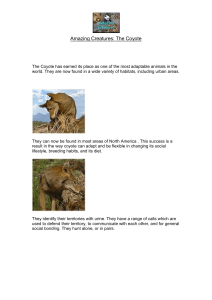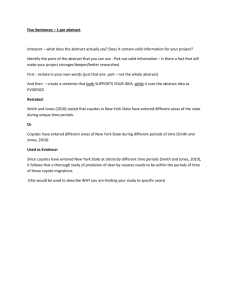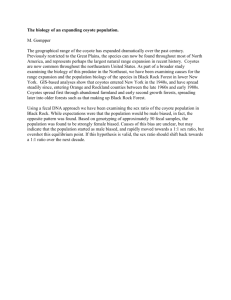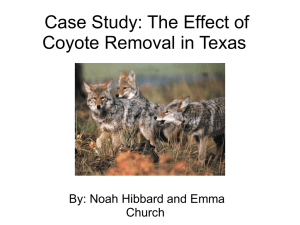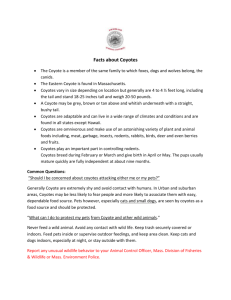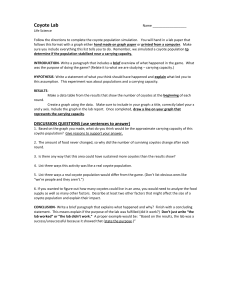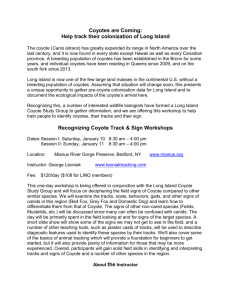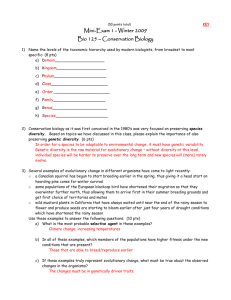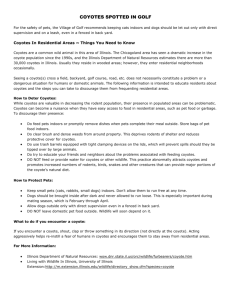The Coyote in Mecklenburg County, N.C. Canis latrans
advertisement
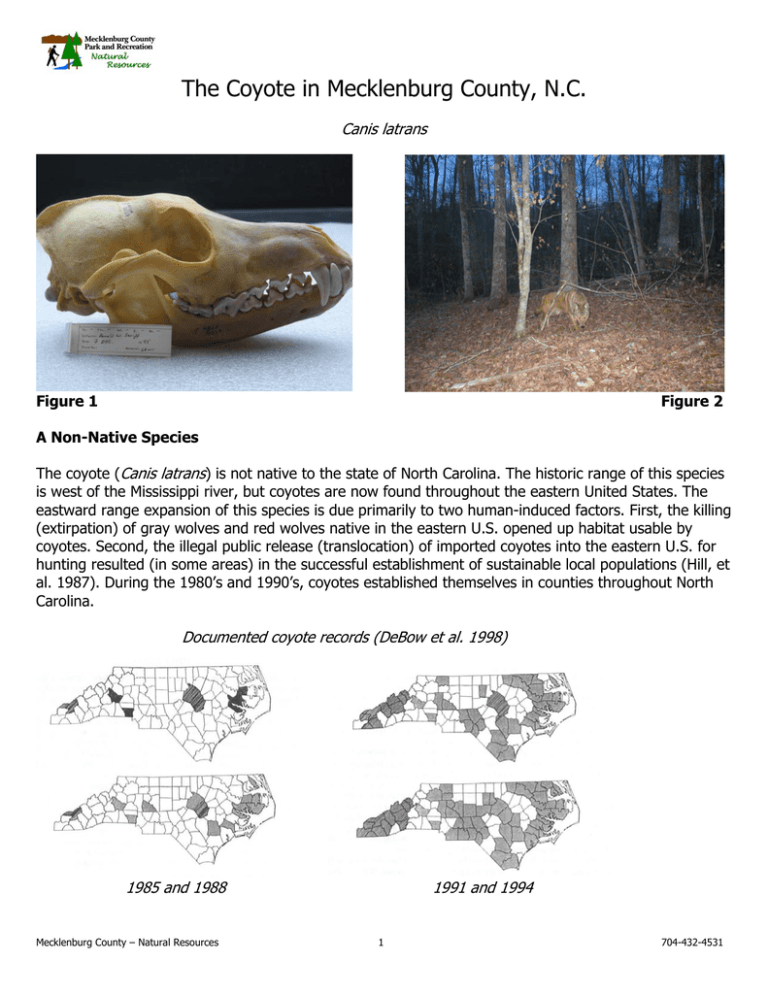
The Coyote in Mecklenburg County, N.C. Canis latrans Figure 1 Figure 2 A Non-Native Species The coyote (Canis latrans) is not native to the state of North Carolina. The historic range of this species is west of the Mississippi river, but coyotes are now found throughout the eastern United States. The eastward range expansion of this species is due primarily to two human-induced factors. First, the killing (extirpation) of gray wolves and red wolves native in the eastern U.S. opened up habitat usable by coyotes. Second, the illegal public release (translocation) of imported coyotes into the eastern U.S. for hunting resulted (in some areas) in the successful establishment of sustainable local populations (Hill, et al. 1987). During the 1980’s and 1990’s, coyotes established themselves in counties throughout North Carolina. Documented coyote records (DeBow et al. 1998) 1985 and 1988 Mecklenburg County – Natural Resources 1991 and 1994 1 704-432-4531 In Mecklenburg County, coyotes were first formally documented on December 7, 1995. A road-killed specimen was discovered in eastern Mecklenburg County by Taylor Piephoff, a local Charlotte naturalist. Don Seriff, Mecklenburg County Natural Resources staff, collected this specimen, partially prepared it, and deposited the specimen in the N.C. State Museum of Natural Sciences in Raleigh, as the first voucher specimen for the county (Figure 1). Since its discovery in the county in 1995, the coyote population within Mecklenburg County has expanded. Today, coyotes are fairly common in both urban and suburban natural areas throughout all parts of the county. Figure 2 shows a 2007 photograph of a coyote taken by an infra-red triggered camera at McDowell Nature Preserve in southwest Charlotte. Adaptable Generalists Coyotes stand 23-26 inches tall at the shoulder and usually weigh between 30 and 40 pounds. They are predominantly brownish gray, but colors can vary between individuals and by season. There are four useful identification characteristics that can assist in separating a coyote from a similar-sized dog: 1) long slender snout, 2) large erect ears, 3) a thick round bushy tail, and 4) a stiff-legged lope, usually noticeable unless they are in an all out sprint, with their tail held below the level of their back. Coyotes are highly adaptable and are generalists in terms of both food needs and overall habitat requirements. Active usually at dusk and dark, they can often live undetected in close proximity with humans without any negative interactions. Because of their ability to exploit a great variety of prey items, coyote diets are extremely diverse. They are opportunistic feeders, often eating what is easiest to catch. They generally hunt small prey animals like rodents, but they will also eat carrion, fruits, berries, bird’s eggs, reptiles, amphibians, and insects. In areas with high human populations they may eat fruits and vegetables from gardens as well as refuse from trash cans and dump sites. Coyotes have been documented in some instances preying on livestock and domesticated animals. In some area, cats and very small dogs can be vulnerable to predation, particularly if left out at night. Human / Coyote Interactions Coyotes exhibit little fear of humans. Encounters with coyotes should be treated the same as with any other wild animal. Back slowly away from them and leave them alone. Under normal conditions, coyotes do not present a danger to people and bites from coyotes are very rare. However, caution is always warranted. Coyotes can become aggressive if they are cornered, or if they feel threatened near their den. Also, an individual affected by disease or pain from an injury can display aggressive actions. In the event a coyote becomes aggressive, back slowly away while yelling and waving your arms. Throw rocks sticks, or other objects. Do not run. Call 911 as soon as possible to get help from Animal Control. References DeBow, T.M., WM. D. Webster, and P.W. Sumner. 1998. Range expansion of the coyote, (Canis latrans) (Carnivora: Canidae), into North Carolina; with comments on some management implications. The Journal of the Elisha Mitchell Scientific Society, 114(3), pp. 113-118. Hill, E.P., P.W. Sumner, and J.B. Wooding. 1987. Human influences on range expansion of coyotes in the southeast. Wildlife Society Bulletin, 15:521-524. Mecklenburg County – Natural Resources 2 704-432-4531 Coyote Safety Tips • Never approach or touch a coyote. • Never feed coyotes or any wild animals directly or indirectly. Be sure to pick up outside food and water bowls once pets have been fed. • Never approach a coyote den. They will respond as a dog responds when a stranger comes to its home / yard. • Store trash in covered, heavy-duty animal-proof containers. Add ammonia to trash if animals have been raiding trash bins. Avoid open compost bins with food scraps. • Remove thick brush and weeds around homes that may harbor rodents. The presence of rodents may attract coyotes. • Keep cats and dogs inside as much as possible. Keep small dogs on a leash when walking them outside. Do not walk small dogs at dusk or at night. An unattended small dog or cat can be an easy prey item for a coyote. • Be a threat: Chase of coyotes when you see them. Throw sticks, yell, wave your arms, spray them with a hose to chase them away. This will help keep a den from being located nearby and will help them to maintain a level of fear towards humans. • Fence off outside animal enclosures and include a top. Coyotes can jump a 6’ high fence. • Enclose the bottoms of porches or decks and maintain outdoor storage sheds in a manner that prevents animals from using them for cover. Mecklenburg County – Natural Resources 3 704-432-4531
